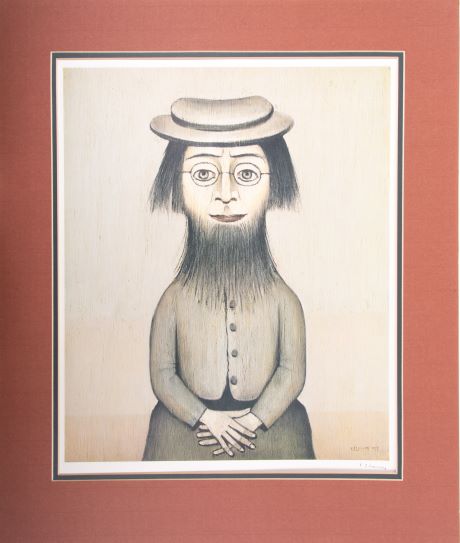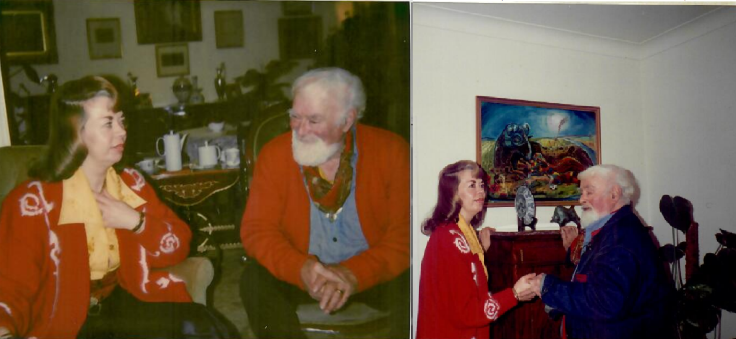Signed L.S. Lowry prints form part of upcoming Monty Bloom collection
Within Dawsons' Fine Art & Antiques Auction, 9th December at 9:30am
Dawsons are delighted to be selling several works from the collection of Monty Bloom in their upcoming December Fine Art & Antiques auction.
30/11/2020
Dawsons are delighted to be selling several works from the collection of Monty Bloom in their upcoming December Fine Art & Antiques auction.
Monty Bloom a successful businessman and collector originally based in the North West, clearly had both refined and eclectic taste. Apart from several signed prints and an early sketch by L. S. Lowry - dating from his days at art school in around 1906 - the collection offered at Dawsons also includes a Modernist bronze sculpture attributed to Northern sculptor John Mulvey, a 19th century Chinese ivory carved sculpture of two seated deities playing ‘Go’, as well as two paintings and two stone carvings by the intriguing painter, writer and sculptor Sven Berlin.
Image from A COLLECTOR’S LIFE' Monty Bloom and L.S. Lowry © Martin Bloom, 2020
Auctioneer & Valuer, Harrison Goldman said of the sale, “Whilst the name L. S. Lowry is a household name today, it was only later on in his career that he received the appreciation he deserved. Arguably, one of the key figures to thank is Monty Bloom... If you read any biography or early catalogue on Lowry, Bloom will be referenced on multiple occasions.”
Keen to preserve the fascinating story of these works, Dawsons have included with each item from the collection a label of provenance of being purchased directly by Monty Bloom from the artist or personal gifts and thus never been on the open market. Interestingly, most of the Lowry prints are unnumbered, adding to the personal connection of being presented to Monty rather than part of the standardised print run that would be numbered for sale on the commercial market.
Below his son Martin Bloom shares insight with Dawsons into his father’s fascinating collection and links to one of England’s greatest 20th century artists:
Extract from A COLLECTOR’S LIFE: Monty Bloom and L.S. Lowry © Martin Bloom, 2020
Chance plays a part in many lives. For my father, Monty Bloom, there were many random steps leading him to first meet and then become a close friend of L.S. Lowry and a collector of his works. My father was not at that stage an art collector but found in the images he saw in John Read’s 1957 documentary on L.S. Lowry reminiscences of his upbringing in Ebbw Vale. Nostalgia drove him to seek out these works. His accountant knew Lowry and my father commissioned two works, meeting Lowry by chance at an exhibition of the art of two chimpanzees curated by Roland Penrose. (His son Tony Penrose had an influence on my own artistic career, curating a joint exhibition of my works and those of his mother, the late Lee Miller.) From that first meeting, Lowry and my father met regularly, and in time once a week, often coming over to our house for tea. My mother’s apple pie was drowned in a large lake of cream, as this tall jovial man laughed and joked while consuming the last crumb and draining the bowl. My father was drawn to his personality. “His low-key humour was a perfect foil for Lowry’s hilarity, his ingenuous manner ideally matched to the artist’s own” (Shelley Rohde in A Private View of L.S. Lowry, William Collins, 1979).
My father met Lowry at a critical period of his life. Lowry had started moving away from the traditional industrial landscapes for which he is best known and started creating single figures, isolating his characters from their surroundings. He became obsessed “with the grotesque and the deformed”, a subject for which he despaired of finding interest from collectors. My father was drawn to these and became a major collector. “The Bloom Collection is notable because it covers the whole range of Lowry’s art, from its beginnings, about 1906, until today. … [It] has particular value because it follows the development of Lowry’s mood.” (Maurice Collis, in L.S. Lowry, Hamet Gallery exhibition catalogue, 1972).
One particular painting in that 1957 documentary was purchased by my father, together with the original drawing upon which it is based, and a signed numbered print of it is for sale within Dawsons December sale. Woman with a Beard was based on a bearded woman Lowry met on a train journey to Paddington. Mervyn Levy in his book, The Paintings of L.S. Lowry, sees it as “a succinct example of the artist’s power to express the terrible isolation of the individual soul, an isolation unquestioned and blithely accepted. Everything is concentrated in the face itself, the setting from which we can extricate ourselves only by renunciation of self. Lowry’s imagery is the measure of a common destiny.”

L.S. Lowry's 'Woman with a Beard' - A signed lithoraphic print (estimate: £1200 - £1800)
To some extent, the industrial revolution and its aftermath tied Lowry to my father. Manchester’s role in the industrial revolution was based around the textile industry and its mills, driven by the increased use of coal for producing the steam power used for the mills and for transport. South Wales was a major source of coal and iron, driving on the industrial revolution even faster and transforming society.
In effect, Lowry documented the impact of the industrial revolution on post-industrial Manchester and Salford, showing the human costs with the isolation of its inhabitants as they were ripped from their original villages and extended families, especially through his later works. My father moved to Manchester and its surroundings, where I was born. He took over failing businesses and turned them around, giving them new life. After he started collecting the single figures, my father then took Lowry to visit the sites of his youth in South Wales and the cycle continued. Lowry painted some of his most unique and important industrial landscapes there. “It was as if [Lowry] had explored every crevice of the industrial panorama. There were few other combinations … he could develop. … Only the discovery of the mining villages of South Wales with his friend and collector Monty Bloom, reawakened Lowry’s interest. Even there, it was the stunning mix of rugged countryside and industrial towns which excited him.” Michael Leber in L.S. Lowry (Phaidon, 1987).
 L.S. Lowry's 'Hillside' - A signed lithographic print (estimate: £3000 - £5000)
L.S. Lowry's 'Hillside' - A signed lithographic print (estimate: £3000 - £5000)
Through Lowry, my father was introduced to other Northern artists - Theodore Major, Sheila Fell and Gladys Cooper, amongst others - and he collected a number of their works. Gladys Cooper was a so-called naïve artist discovered by Theodore Major when she attended one of his courses in 1951. Her Xmas Day 1955 (shown below) is under the hammer with Dawsons in December.
 Gladys Cooper's 'Xmas Day 1955'
Gladys Cooper's 'Xmas Day 1955'
My father had to leave the North West for health reasons. His lungs had become weak because of medical treatment in the United States while training as an airman during the early years of the Second World War. Each winter he suffered from bronchitis which then developed into pneumonia. He was advised by his doctor to move and so Bournemouth became his destination.
It was here in 1988 he met another artist, Sven Berlin, with a very different personality to Lowry, though also a loner. Sven was a writer, sculptor and painter. My father used to visit The Old Keepers Cottage at Gaunts Common near Wimborne frequently until shortly before his death in 1996. My father purchased a range of Sven’s works, together with some of his original manuscripts. Yet, as with Lowry, it was his personality that attracted my father to him.
 Sven Berlin at the Bloom family home
Sven Berlin at the Bloom family home

Veronique has worked within her chosen specialism for nearly 30 years, firstly with Sotheby’s and latterly with Bonhams as a Director and Head of Pictures at Bonhams Knightsbridge, and she would be delighted to help provide valuations and sales advice in respect of any pictures and paintings you may be considering selling or buying.
Paintings Prints Watercolours